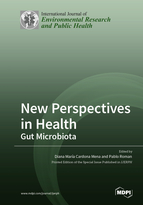New Perspectives in Health: Gut Microbiota
A special issue of International Journal of Environmental Research and Public Health (ISSN 1660-4601). This special issue belongs to the section "Environmental Microbiology".
Deadline for manuscript submissions: closed (31 January 2022) | Viewed by 56167
Special Issue Editors
Interests: microbiota; gut-brain-axis; neurotoxicity
Special Issues, Collections and Topics in MDPI journals
Interests: gut microbiota; gut-brain-axis; functional food; probiotic; clinical trials; systematic review
Special Issues, Collections and Topics in MDPI journals
Special Issue Information
Dear Colleagues,
Gut microbiota is an area recently targeted by modern biomedical research. In fact, during the last five years, there has been increasing evidence related to the role of gut microbiota as a remarkable symbiotic partner critical for the maintenance of good health. Several factors cause alteration in gut microbiota which are, indeed, accompanied by alterations to the quality of health. Accordingly, gut microbiota dysbiosis has been related to increased susceptibilities to intestinal, cardiovascular, and nervous pathologies. However, more research is required to elucidate the role of microbiota, its outcomes in health diseases, and the underlying pathways.
We invite you to submit a manuscript for publication in this Special Issue dedicated to evaluate the role of gut microbiota in health, which may be an original research article (preclinical or clinical) or review. Important topics include but are not limited to interactions between gut microbiota and several health conditions (digestive disorders, health mental disorders, cardiovascular disorders, etc.); factors that alter gut microbiota (exposure to toxic substance, stress, nutrition, habits, etc.); changes in the gut microbiota throughout lifetime; modulators of the microbiota as therapy for different health disorders (prebiotics, probiotics, fecal transplantation, etc.); and the gut–brain axis and its implication for health.
We thank you for considering this invitation and are available for any inquiries.
Prof. Dr. Diana María Cardona Mena
Dr. Pablo Roman
Guest Editors
Manuscript Submission Information
Manuscripts should be submitted online at www.mdpi.com by registering and logging in to this website. Once you are registered, click here to go to the submission form. Manuscripts can be submitted until the deadline. All submissions that pass pre-check are peer-reviewed. Accepted papers will be published continuously in the journal (as soon as accepted) and will be listed together on the special issue website. Research articles, review articles as well as short communications are invited. For planned papers, a title and short abstract (about 100 words) can be sent to the Editorial Office for announcement on this website.
Submitted manuscripts should not have been published previously, nor be under consideration for publication elsewhere (except conference proceedings papers). All manuscripts are thoroughly refereed through a single-blind peer-review process. A guide for authors and other relevant information for submission of manuscripts is available on the Instructions for Authors page. International Journal of Environmental Research and Public Health is an international peer-reviewed open access monthly journal published by MDPI.
Please visit the Instructions for Authors page before submitting a manuscript. The Article Processing Charge (APC) for publication in this open access journal is 2500 CHF (Swiss Francs). Submitted papers should be well formatted and use good English. Authors may use MDPI's English editing service prior to publication or during author revisions.
Keywords
- gut microbiota
- gut–brain axis
- dysbiosis
- microbiome
- modulatory effects of gut microbiota
- probiotics
- prebiotics
- functional food







